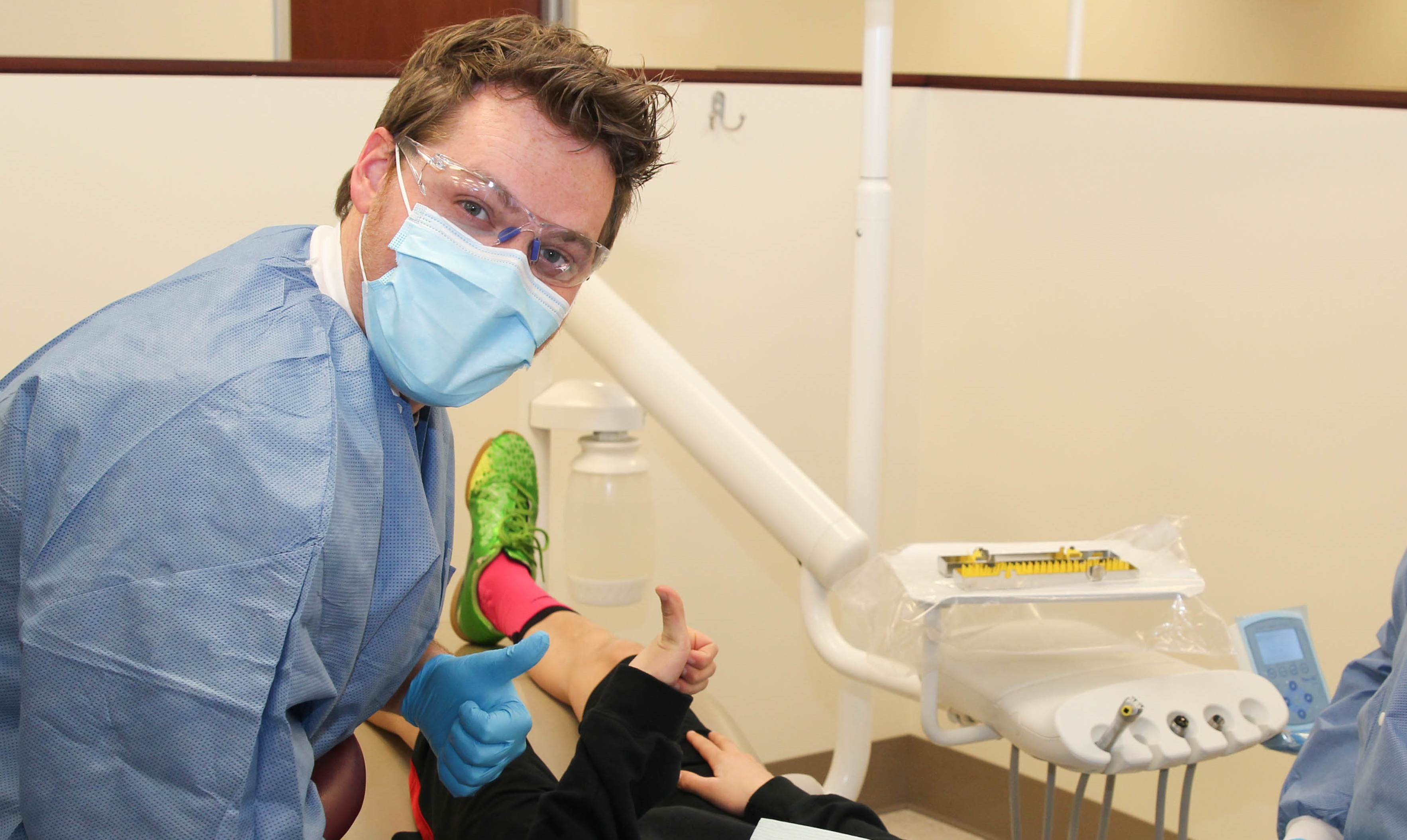by Roseman Dental | Mar 30, 2016 | Dental Clinic Blog, Dental School, Oral Health, Roseman Dental - NV, Roseman Dental - UT
While you might have a basic understanding of tooth decay, there’s likely much about the topic you don’t yet know. A deeper understanding of your oral health allows you to know when you have a problem that is likely to take care of itself and when you have one that requires a professional treatment from a dentist. Learn more about tooth decay and how to take the best care of your pearly whites.
Age Makes a Difference in Tooth Decay
One of the first things to know about tooth decay is that it’s more common now than ever in children and babies. A child’s teeth aren’t as developed or strong as an adult’s, so acids, plaque and bacteria will eat away at their teeth. Eating and drinking habits for small children also impact oral health, with many parents not realizing the harmful effects of giving a child a bottle or sippy cup filled with milk or juice when they go to sleep, or to drink throughout the day. Snacking on things like fruit snacks, starchy crackers, or sugary treats throughout the day—called “grazing”—is also harmful to a child’s teeth.
Recognizing the Signs of Tooth Decay
Knowing what tooth decay looks like is another essential component of treating it. Indications of tooth decay include:
- Discolored teeth
- Bad breath or a bad taste in your mouth
- Inflammation of the gums around a sore tooth, which is also a sign of an abscessed tooth
- An ongoing or recurring toothache
Properly Diagnosing Tooth Decay
To rule out an abscess and anything else that might be going on with your teeth, your dentist will make sure you actually have tooth decay in order to prescribe proper treatment. You’ll likely be asked questions about your medical and dental history before the dentist uses a small mirror to examine your teeth. You might also have X-rays taken of your mouth and teeth to better pinpoint which of your teeth may be decayed. Common treatments for tooth decay that has worked through tooth enamel include fillings, crowns, tooth extraction and root canals.
Oral health is a large component of your overall health. By taking good care of your teeth, you’re taking equally good care of the rest of your body as well.

by Roseman Dental | Mar 14, 2016 | Dental Clinic Blog, Dental School, Roseman Dental - NV, Roseman Dental - UT
The recommendation that you visit your dentist at least twice a year certainly isn’t anything new, but when you get to your dental office you might notice that there are several things that are changing about the way you receive care and interact with the staff and the dentist. Today’s dentists are increasingly embracing technology as a way to offer a higher level of care and a more streamlined visit. Here are just a few of the trends you might see next time you visit your dentist.
Minimally Invasive Treatments
You might not believe it, but dentists don’t like drilling your teeth any more than you like having them drilled. Fortunately with advances in dental technology and treatment methods, more and more procedures can be performed in a way that is “minimally invasive”. The goal with these treatments is to conserve as much of your healthy tooth structure as possible, removing the least amount of natural tooth to achieve a long-lasting positive result. Fixing crooked teeth and other malocclusions has also become easier and less invasive with products like Invisalign®, while advances in treating cavities and other oral health-related problems have led to better and longer-lasting outcomes.
Dental Implants
Another improvement to dental treatment in recent years is the more widespread use of dental implants to improve the appearance and function of your teeth without damaging or impacting the teeth that surround it. Dental implants or implant-supported dentures have quickly become a popular option for many people who have damaged or missing teeth, although they are not an option in every case. Visit The Dental Clinic at Roseman University to find out more about dental implants if you think you might be a candidate.
Technology in the Dental Office
Rapid advances in technology have impacted the way we do business, the way we communicate, and our overall health and wellness—including dental health. Today many dentists are using digital CAD/CAM technology (computer-aided design/computer-aided manufacturing); with a small wand about the size and shape of an electric toothbrush, your dentist can create a digital image of your mouth and the shape of oral structures inside.
“Traditional impressions that record the shape and configuration of teeth and mouth can often be replaced with scans from laser or LED light cameras. The digital file is sent to a 3D printer or milling machine to create a model made of lightweight, durable resin,” said Dr. Doug Ashman, a professor at Roseman University College of Dental Medicine. “The advantage of this approach, beyond the obvious improvement in the patient’s comfort, is the increased accuracy of the digital impression and the ability to store and retrieve the image at a later time, as needed.”
Similar technology can be used to create crowns and fixed bridges, and with the help of sophisticated software, the dentist can create a uniquely designed and perfectly shaped crown ready for implant, often in just a matter of minutes while the patient waits in the dental chair.
Other technology you might start to see at your dental office includes software and apps that allow you to schedule appointments with ease, fill in your health history prior to arriving at the dentist’s office, and get things like text and voicemail reminders when it’s time for your appointment.
While the trends in dental medicine are improving the way patients receive treatment and interact with their dental office, there is one trend that is never going away: having a healthy smile and a healthy mouth will always be in style.

by Roseman Dental | Feb 17, 2016 | Clinic Events - UT, Dental Clinic Blog, Dental School, Oral Health, Roseman Dental - UT
By: Raymond Durham, Roseman DMD Class of 2017
On the ADA Foundation’s Give Kids a Smile® (GKAS) kick-off day, February 5, Roseman University’s College of Dental Medicine held its 3rd annual GKAS event at our Dental Clinic. As a non-profit institution of higher education, Roseman University is committed to improving oral health care for children in Utah and throughout the Intermountain West.
The event provides a unique opportunity to increase access to care for these children, while also allowing dental students to participate in an important cause that they will hopefully continue when they enter a career as a dental provider.
The ADA Foundation began Give Kids a Smile to raise awareness for “children who do not receive dental care…and to establish a dental home,” according to the ADA Foundation website (adafoundation.org). Roseman’s approach to GKAS parallels that goal by providing free dental care for children on the day of the event, offering vouchers for patients to return for future care, and providing an affordable option for families that otherwise do not have access to dental care. Previous events have resulted in about 45 percent of patients returning to The Dental Clinic at Roseman University as their dental home. Of these, over 80 percent reported having no dental insurance, 50 percent had not seen a dentist in over a year, and 48 percent had unmet dental needs, including decay. Perhaps more importantly, children who participated in the event received a positive experience at a dental office and were able to learn more about the importance of oral health care.
“Meeting student doctors, playing games, and learning about dental health is a great opportunity to establish a positive lasting effect for children regarding their oral health care. Hopefully events like this plant a seed to help children maintain their oral health and feel comfortable attending the dentist throughout their life,” said Dr. Aaron Ferguson, Director of Public Health Education at Roseman University College of Dental Medicine.
At the 2016 event, 503 children received limited exams, cleanings, and sealants. The total estimated value of the services provided the day of the event is over $90,000. Additionally, all children who attended the event received a voucher to return for a comprehensive exam, a complete set of radiographs (X-rays), and $50 to put toward future care if needed.
In total Roseman University’s Give Kids a Smile program will result in over $214,000 worth of dental care donated to the community, and a dental home for hundreds of children in need. We are excited about the success of this year’s event, and look forward to next year’s Give Kids a Smile® event.
You can find more information about The Dental Clinic at Roseman University, which offers affordable dental care for the whole family in the Salt Lake area, and about future events here. If you missed Give Kids a Smile, remember that you can always come in for a screening at no cost. Just call 801-878-1200 to schedule it.
by Roseman Dental | Feb 10, 2016 | Dental Clinic Blog, Dental School, Roseman Dental - NV, Roseman Dental - UT
Deciding on a career path can be daunting for many people because there are a lot of rewarding professions out there, and you often have to make a decision about what you will do for the rest of your life at a young age. If you are interested in a career in the health professions but you’re not so sure about being a doctor or nurse, then you might want to consider dentistry. This appealing profession offers many advantages.
A Balanced Lifestyle
One reason becoming a dentist is so appealing is because the job provides a balanced lifestyle. Most dentists enjoy free time and flexibility. This makes it easier to balance the demands of family and personal life.
Service Oriented Industry
Dentists are service-oriented individuals who spend their days helping others improve their oral health. Through their efforts, they often improve people’s appearance as well.
Respected Career
Many people respect dentists and value their knowledge. This profession has a very positive connotation, and several of the top dentists are also leaders in their community.
Hands On Career
If you like hands on activities, then becoming a dentist is a great option. You will be able to use both creative and scientific talents to help others. In addition, you will spend your time detecting disease and treating problems.
Opportunity for Generating Income
There is a lot of opportunity for people with a background in dentistry. People of all ages require dental work, and there is a particularly strong demand for dentists among older individuals. With the elderly population going up and people living longer, this means you will have many opportunities for generating a good income.
Self-Employment
A lot of dentists are self-employed, and they own their practices. This enables them to be their own boss. The efforts you make each day directly benefit your financial well-being, and you can decide what patients you want to treat, where you want to live, and how often you want to work.
These are just a few compelling reasons to consider becoming a dentist. Many people love their job as a dentist, and this can be a very rewarding career path. Whether you are attracted to the flexibility, the environment, or any of the other benefits, there are a lot of advantages that come with this profession.
by Roseman Dental | Dec 10, 2015 | Dental Clinic Blog, Dental School, Oral Health, Roseman Dental - NV, Roseman Dental - UT
Whether you specialize in pediatric dentistry or want to make sure your family practice is child-friendly, it’s important to have a wide repertoire of techniques at your disposal to calm children when they are having dental work done. You may even find that some of these techniques also work for skittish adults.
Engage and Educate
Although it isn’t necessary to turn your entire waiting area into a playroom, having activities that engage children while they wait for their appointment can go a long way toward keeping the anxiety at bay prior to their appointment time. You can choose to go the educational route, and use the waiting time as an opportunity to explain some things about the visit and their teeth and what to expect during their appointment, or you can provide movies, games, and toys.
Communicate
It’s important to address fears children might have by allowing them to talk about those fears, and by letting them know what to expect. Fully explaining what will happen during the visit gives them the opportunity to ask questions and can ease some of the fear of the unknown. Make sure they have a way to communicate with you throughout the procedure, or check in with them periodically to let them know how much longer they’ll be in the chair.
Involve Parents
Sometimes just the presence of a parent or familiar face in the exam room may help the child feel more safe and comfortable, especially if it’s their first time. Collaborating with the parent to demonstrate what will happen during the visit is an excellent strategy. You can explain to the child what will occur, demonstrate it on the parent, and then do the procedure with the child.
Parents also have a role in ensuring that children see the dentist for the first time at an early age (preferably by the time they turn 1) so children can have positive experiences from the beginning and learn that the dentist is not a place they should fear. If parents wait until a child requires extensive treatment, visits to the dentist will likely be viewed as fearful or painful events.
Using some or all of these techniques should help children manage their anxiety at the dentist. Doing so can visit more productive and enjoyable for everyone.
by Roseman Dental | Oct 2, 2015 | Dental Clinic Blog, Dental School, Roseman Dental - NV, Roseman Dental - UT
The first Friday in October every year is designated World Smile Day, a holiday that was initiated by the inventor of the iconic yellow smiley face, commercial artist Harvey Ball. The Smile Foundation that was created in his memory strives to improve the world one smile at a time. Harvey Ball and the Smile Foundation know how important a single smile can be, but the many benefits of smiling may surprise you.
- Your smile can make you happy. Feeling happy can make you smile, but the reverse is true as well. Studies have shown that smiling, whether genuine or forced, can release endorphins that create an authentic feeling of happiness, so next time you’re upset or stressed, put a smile on your face and trick your brain into changing your mood!
- Your smile can make someone else happy. A smile is like a yawn – when you see one, you instinctively copy it, and the happiness circuits in your brain light up. The same goes for everyone else, so greet the world with a smile on your face and others will instinctively smile back, increasing happiness everywhere you go.
- Your smile can help you relax. When you smile, your brain releases chemicals that can fight off stress, relax your body and lower your heart rate and blood pressure. The chemicals released can also diminish feelings of pain and depression.
- Your smile can make you seem more attractive. Most people perceive someone with a pleasant expression as attractive and sincere. When you smile, you seem more approachable and more likeable. There’s no easier way to increase your appeal.
- Your smile can land you a job. A smile can also make you seem more reliable and trustworthy, traits that an interviewer may value. By making eye contact and smiling when greeting a potential employer, you signal that you are confident, pleasant and capable.
Whether you’re feeling down or looking to make a good impression, take a minute to remember a joke or a pleasant memory and let the thought bring a smile to your face. This World Smile Day, remember that a smile costs nothing, but benefits you and everyone you see.




